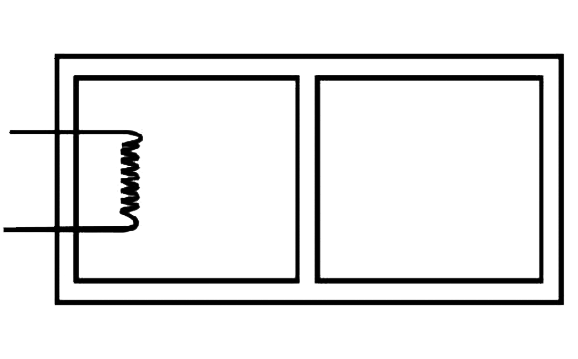An experiment takes 10 minutes to raise the temperature of water in a container from 0∘Cto100∘C and another 55 minutes to convert it totally into steam by a heater supplying heat at a uniform rate. Neglecting the specific heat of the container and taking specific heat of water to be 1cal/g∘C, the heat of vapourization according to this experiment will come out to be:-Solution in Gujrati
540cal/g
530cal/g
560cal/g
550cal/g
The correct Answer is:D
Let M is mass of water and P is amount of heat supplied per unit minute.
MSW(100−0)=P×10…..(i)
MLV=P×55….(ii)
(i)/(ii) we get LV=550cal/g
Topper's Solved these Questions
- GEOMETRICAL OPTICSBOOK - ALLEN CHAPTER - GEOMETRICAL OPTICSEXERCISE - EXERCISE - 05 (B)
58 Videos
- GEOMETRICAL OPTICSBOOK - ALLEN CHAPTER - GEOMETRICAL OPTICSEXERCISE - EXERCISE - 05 (B) (MCQ)
9 Videos
- GEOMETRICAL OPTICSBOOK - ALLEN CHAPTER - GEOMETRICAL OPTICSEXERCISE - EXERCISE - 04 (B)
15 Videos
- CURRENT ELECTRICITYBOOK - ALLEN CHAPTER - CURRENT ELECTRICITYEXERCISE - EX.II
66 Videos
- GRAVITATIONBOOK - ALLEN CHAPTER - GRAVITATIONEXERCISE - EXERCISE 4
9 Videos
Similar Questions
A vessel contains a mixture of one mole of oxygen and two moles of nitrogen at 300K. The ratio of the average rorational kinetic energy per O2 molecules to that per N2 molecules is
View SolutionLet ¯v,vrms and vp respectively denote the mean speed, the root-mean - square speed, and the most probable speed of the molecules in an ideal monoatomic gas at absolute temperature T. The mass of a molecule is m:-
View SolutionThe rectangular box shown in Fig has partition which can slide without friction along the length of the box. Initially each of the two chambers of the box has one mole of a mono-atomic ideal gas (λ=5/3) at a pressure P0, volume V0 and temperature T0. The chamber on the left is slowly heated by an electric heater. The walls of the box and the lead wires of the heater is negligible. The gas in the left chamber expands pushing the partition until the final pressure in both chambers becomes 243P0/32. Determine (i) the final temperature of the gas in each chamber and (ii) the work done by the gas in the right chamber.

View SolutionIn the Bohr's model of hy drogen atom, the electron moves around the nucleus in a circular orbit of radius 5×10−11m. Its time period is 1.5×10−16s. The current associated with the electron motion is:-
View SolutionAssertion : The difference in the value of acceleration due to gravity at pole and equator is proportional to square of angular velocity of earth.
Reason : the value of acceleration due to gravity is minimum at the equator and maximum at the pole.
View SolutionWater at 0^@C was heated until it started to boil and then until it all changed to steam. The time required to heat water from 0^@C to 100^@C is 5 min and the time to change boiling water to steam is 28 minutes. If the flame supplied heat at a constant rate, the specific latent heat of vaporisation of water (neglecting heat losses, container etc. is (in J//g ). (specific heat of water s =4.2 J//g )
View SolutionSteam at 100^(@)C is passed into 20 g of water at 10^(@)C when water acquire a temperature of 80^(@)C , the mass of water present will be [Take specific heat of water = 1 cal g^(-1).^(@) C^(-1) and latent heat of steam = 540 cal g^(-1) ]
View SolutionA vessel containing 100 g ice at 0^(@)C is suspended in a room where temperature is 35^(@)C . It was found that the entire ice melted in 10 hour. Now the same vessel containing 100 g of water at 0^(@)C is suspended in the same room. How much time will it take for the temperature of water to rise to 0.5^(@)C . Neglect the heat capacity of the vessel. Specific heat of water and specific latent heat of fusion of ice are 1 cal g^(-1) .^(@)C^(-1) and 80 cal g^(-1) respectively.
View SolutionCalculate the amount of heat required to convert 10g of water at 30^(@)C into steam at 100^(@)C . ( Specific latent heat of vaporization of water = 540 cal//g )
View SolutionCalculate the amount of heat required to convert 10g of water at 30∘C into steam at 100∘C . ( Specific latent heat of vaporization of water =540cal/g )
View SolutionWater heating by a constant heat heater in an experiment 100^(@) It takes 10 minutes to rise to C and 55 minutes to turn it completely into steam. Secret heat of vaporization will be obtained
View SolutionThe amount of heat required to convert 1 g of ice (specific heat 0.5 cal g^(-1).^@C^(-1) ) at -10^@C to steam at 100^@C is
View SolutionSteam at 100∘C is passed into 20 g of water at 10∘C. When water axquires a temperature of 80∘C, the mass of water present will be [Take specific heat of water 1calg−1c−1 latent heat of steam = 540 cal/g−1]
View Solution20g of steam at 100∘C is passed into 100g of ice at 00C. Find the resultant temperature if specific latent heat of steam is 540 callg., specific latent heat of ice is 80 cal/g and specific heat of water is 1 cal/g0 C .
View SolutionAn experiment takes 10 minutes to raise temperature of water from 0∘C to 100∘C and another 55 minutes to convert it totally into steam by a stabilized heater. The latent heat of vaporization comes out to be -
View SolutionThe amount of heat required to raise the temperature of 75 kg of ice at 0°C to water at 10°C is (latent heat of fusion of ice is 80 cal/g, specific heat of water is 1 cal/g °C)
View Solution
